25+ SAMPLE Construction Proposal Form
-
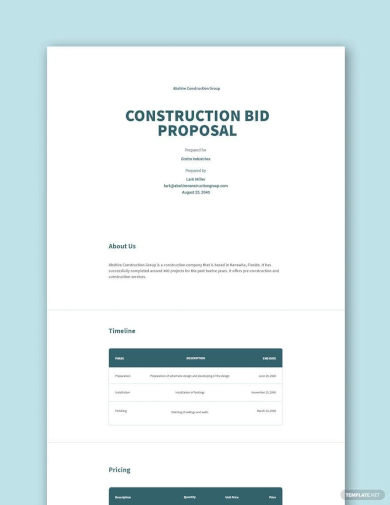
Sample Construction Bid Proposal Template
download now -
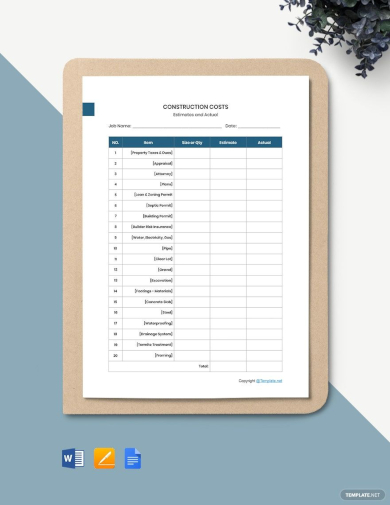
Sample Construction Form Template
download now -
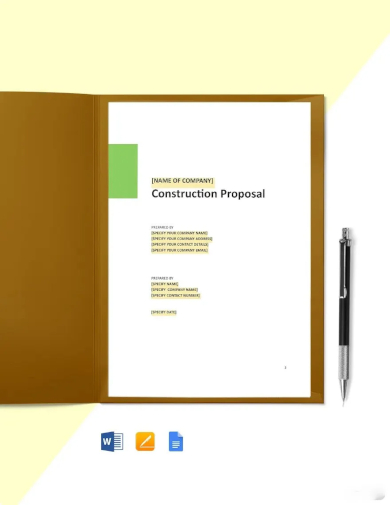
General Construction Proposal Template
download now -
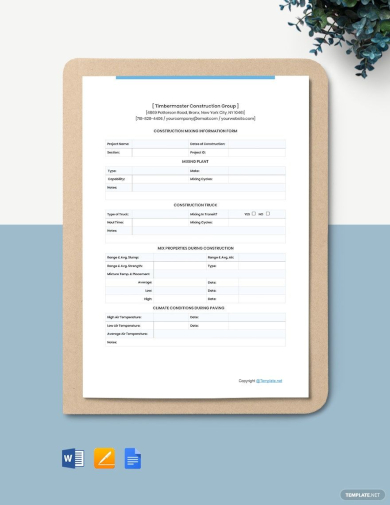
Editable Construction Form Template
download now -
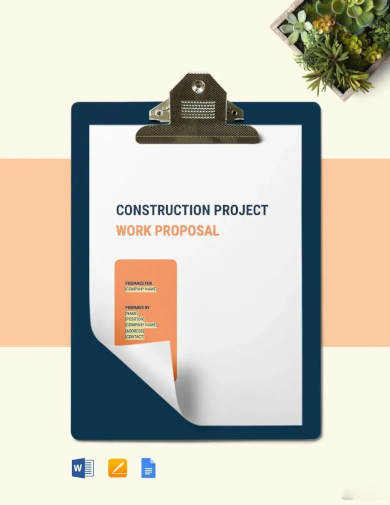
Residential Construction Proposal Template
download now -

Construction Partnership Proposal Form
download now -

Construction Bid Proposal Form
download now -
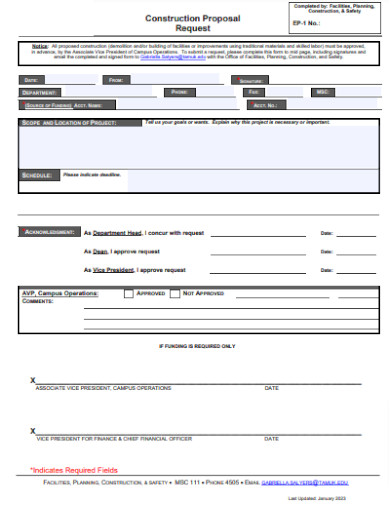
Construction Request Proposal Form
download now -

Construction Project Proposal Form
download now -
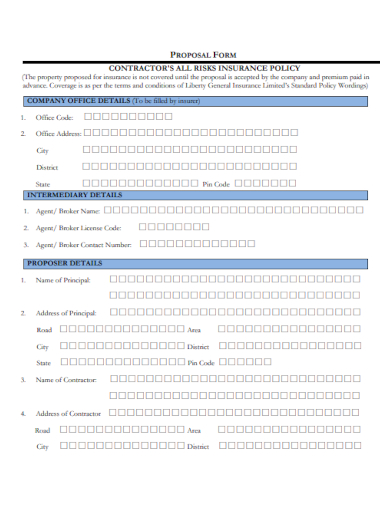
Contractor Insurance Proposal Form
download now -
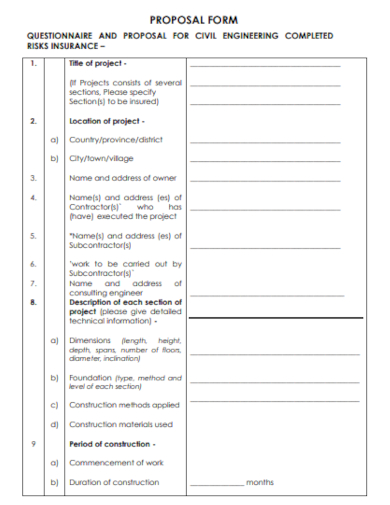
Construction Engineering Proposal Form
download now -
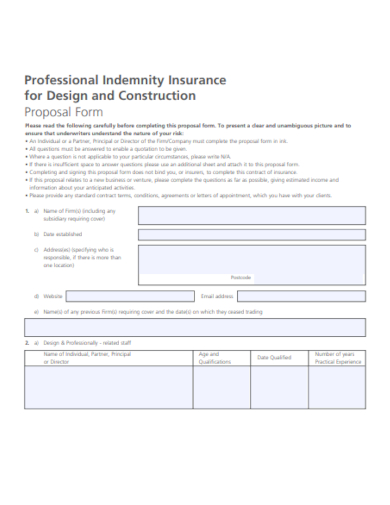
Design and Construction Proposal Form
download now -
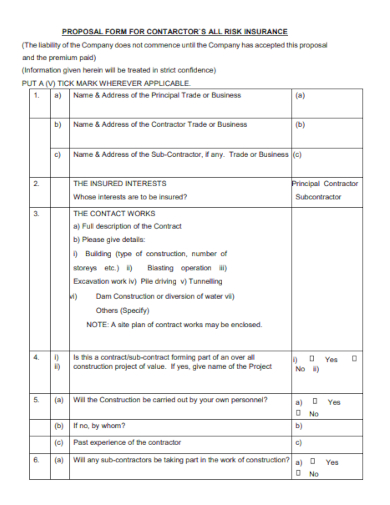
Construction Insurance Proposal Form
download now -
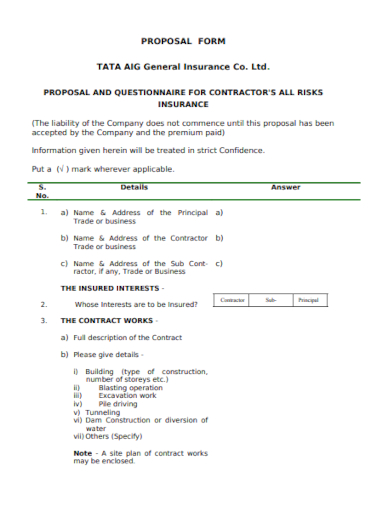
Construction Risk Insurance Proposal Form
download now -
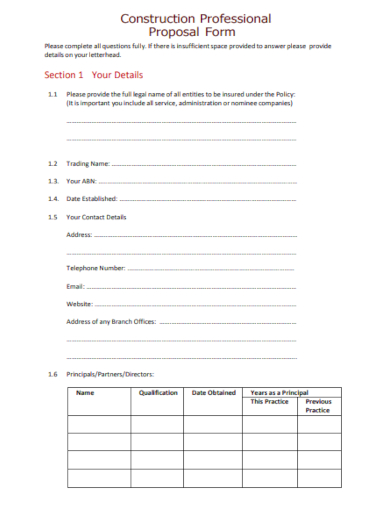
Construction Professional Proposal Form
download now -
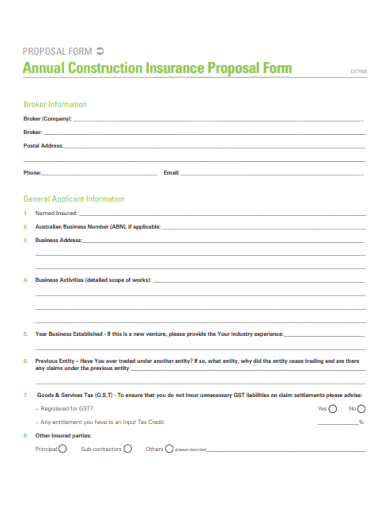
Annual Construction Insurance Proposal Form
download now -
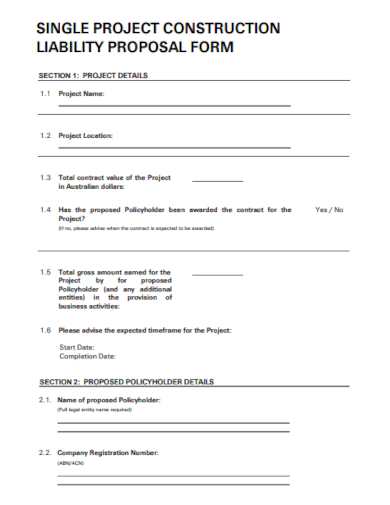
Construction Liability Proposal Form
download now -

Construction Fee Proposal Form
download now -
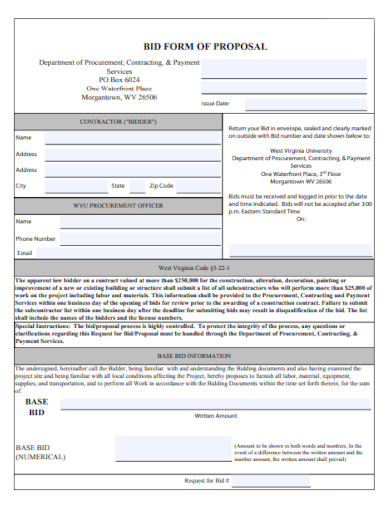
Construction Bid Form of Proposal
download now -
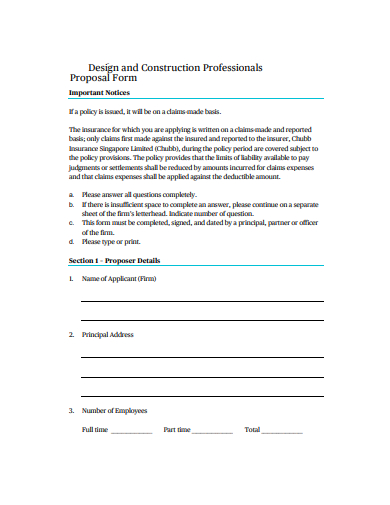
Design and Construction Professional Proposal Form
download now -
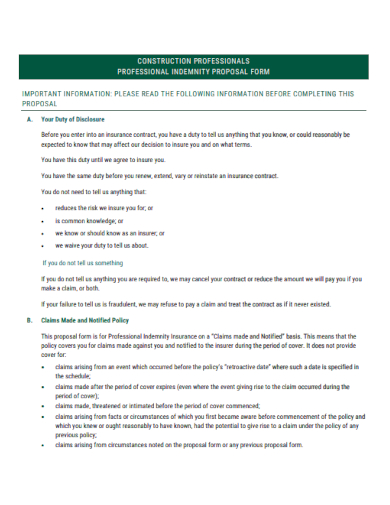
Construction Professional Indemnity Proposal Form
download now -
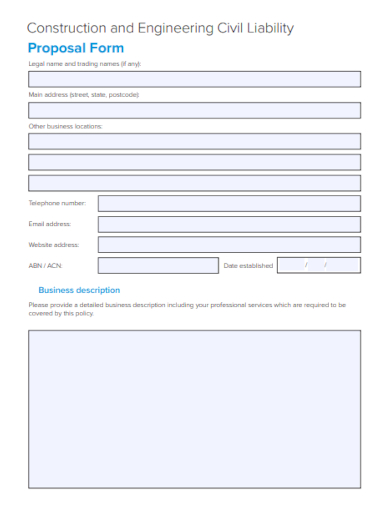
Construction and Engineering Liability Proposal Form
download now -

Proposal Form for Construction Contractor
download now -
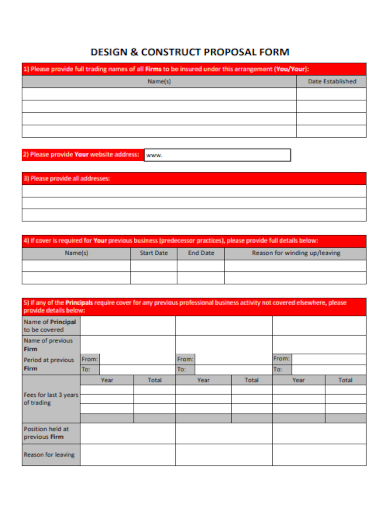
Design and Construct Proposal Form
download now -
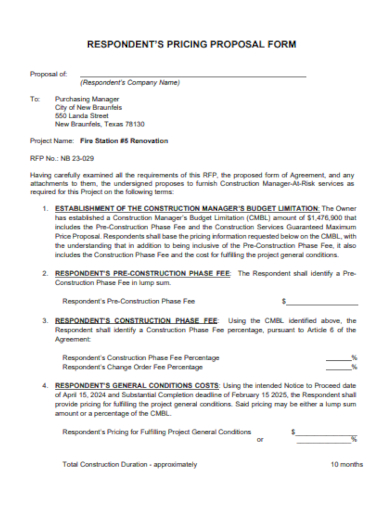
Construction Pricing Proposal Form
download now -

Proposal Form for Construction Professional
download now
FREE Construction Proposal Form s to Download
25+ SAMPLE Construction Proposal Form
Definition:
Understanding the Importance of a Construction Proposal Form:
Delving Deep into the Elements:
The Role of Digitalization:
Crafting a Win-Win Proposal:
Why is it important to have a well-structured proposal form in the construction industry?
What measures are taken to ensure that the form is legally binding once signed?
How can a construction proposal form help contractors and clients communicate effectively?
Can the proposal form be adapted for use in both the bidding and project execution phases?
How does the form ensure transparency in project costing and budgeting?
Definition:
A Construction Proposal Form is a detailed written offer presented by a contractor to a client outlining the scope of work, materials, labor, timeline, and costs associated with a construction project. This form serves as a foundation for contractual agreements, ensuring both parties have clear expectations and understandings of the project’s terms and deliverables.
Understanding the Importance of a Construction Proposal Form:
In the world of construction, communication is crucial. A clear-cut proposal not only sets the right expectations but also protects both the client and the contractor from potential misunderstandings. A Construction Proposal Form is pivotal in this communication process.
Establishing Clear Expectations:
One of the primary purposes of a construction proposal form is to set clear and concise expectations. By detailing the project’s scope, both the contractor and the client gain a mutual understanding of what the project entails. This mutual understanding reduces the chances of misunderstandings or disputes in the future.
Financial Transparency:
This form is crucial in offering a breakdown of the project’s financial aspects. It details the cost of labor, materials, permits, and other expenses. By providing a transparent view of costs, clients can trust the integrity and fairness of the quoted price.
Legal Protection:
Should disagreements arise, a well-detailed construction proposal form can act as a reference point and a legal document. It serves as evidence of the initial agreement and can be utilized to resolve conflicts.
Professionalism:
A thorough proposal form demonstrates professionalism. It shows potential clients that the contractor is organized, detail-oriented, and dedicated to transparency and clarity. This can significantly boost the contractor’s reputation and credibility.
Efficiency and Organization:
By having all project details in one document, it allows for better planning and resource allocation. The contractor can efficiently organize labor and materials based on the agreed-upon schedule, ensuring that the project stays on track.
Delving Deep into the Elements:
Delving Deep into the Elements of any project, system, or method allows stakeholders to gain a comprehensive understanding and ensure thorough execution. When we dive deeper into the components, we can anticipate challenges, optimize processes, and achieve desired outcomes.
Recognizing Subtleties:
In every system or project, there are nuances that may not be evident at the first glance. By delving deep into its elements, these subtleties come to light. Recognizing these nuances can lead to better decision-making and can prevent potential pitfalls.
Enhancing Efficiency:
A detailed understanding of every component ensures that resources, whether time, money, or manpower, are allocated optimally. With a clear picture of the inner workings, redundancies are eliminated, and processes are streamlined.
Fostering Innovation:
A profound understanding often leads to innovation. When we grasp the core principles and intricate details of a system or process, we’re better positioned to think outside the box. This deep knowledge can spark creative solutions and new methodologies.
Ensuring Consistency:
Consistency is a hallmark of quality. By comprehending the intricacies of each element, we can ensure uniformity in execution, leading to consistent outcomes. This consistency builds trust among stakeholders and clients.
Building Expertise:
Expertise isn’t just about knowing the basics; it’s about understanding the depths. A deep dive into the elements of any subject matter solidifies one’s expertise, making them a valuable resource in their respective field.
The Role of Digitalization:
In today’s tech-driven world, many contractors are moving towards digital proposal forms. These platforms not only streamline the process but also offer features like real-time edits, digital signatures, and instant feedback loops.
Catalyst for Innovation:
Digitalization has emerged as the leading catalyst for innovation in the 21st century. By converting information into a digital format, new tools, platforms, and technologies, such as artificial intelligence, blockchain, and the Internet of Things (IoT), have become accessible and have revolutionized various sectors.
Empowering Businesses:
The business landscape has been transformed by digital platforms and solutions. From e-commerce and digital marketing to remote working tools, companies now have the ability to reach global audiences, streamline operations, and adapt to changing market demands at an unprecedented pace.
Enhancing Communication:
Digital communication tools, from social media to video conferencing, have bridged geographical divides, enabling instantaneous communication. This interconnectivity has bolstered relationships, both personal and professional, and has fostered global collaborations.
Personalized Experiences:
Through data analytics and machine learning, businesses can now offer personalized experiences to consumers. Whether it’s online shopping recommendations or tailored content on streaming platforms, digitalization has made customization the norm.
Driving Sustainability:
Digital solutions are playing a key role in sustainability efforts. Smart cities use digital sensors to optimize resource usage. Renewable energy sources benefit from digital monitoring and predictive maintenance. Moreover, digital platforms raise awareness and mobilize action on environmental issues.
Transforming Education:
The realm of education has been democratized by digitalization. Online courses, e-books, and virtual classrooms have made learning accessible to everyone, everywhere, breaking down traditional barriers.
Advancing Healthcare:
Digital health records, telemedicine, and AI-driven diagnostic tools have redefined patient care. The accessibility and efficiency brought about by digitalization in healthcare save lives and improve quality of care.
Challenges and Considerations:
While digitalization offers numerous advantages, it also poses challenges. Issues of data privacy, cybersecurity threats, and digital divides in underserved communities must be addressed to ensure that digitalization benefits everyone.
Crafting a Win-Win Proposal:
Crafting a Win-Win Proposal is the key to successful negotiations and fruitful long-term partnerships. Such proposals prioritize mutual benefit, ensuring that all parties involved feel valued and satisfied with the outcome. Here’s a guide to developing proposals that leave everyone feeling like a winner.
Understanding Stakeholder Needs:
Begin by thoroughly understanding the needs, priorities, and constraints of all stakeholders. Engage in open dialogues, ask questions, and actively listen to gain insights. This step lays the groundwork for formulating solutions that resonate with everyone involved.
Transparency and Honesty:
In every proposal, it’s essential to be transparent about the benefits, potential risks, and limitations. An honest approach builds trust and ensures that stakeholders have a clear understanding of the proposition’s entirety.
Flexible Approach:
While having a clear goal is important, being adaptable in your approach can facilitate compromise. Offering alternative solutions and showing a willingness to modify certain aspects can often lead to better overall agreements.
Emphasize Mutual Benefits:
Clearly outline how the proposal benefits all parties involved. Highlight shared goals and how collaboration can amplify results. By emphasizing mutual gains, stakeholders are more likely to be invested in the proposal’s success.
Clear Communication:
Avoid jargon and ensure your proposal is articulated in clear, concise terms. Simple language and straightforward explanations prevent misunderstandings and make the proposal accessible to everyone.
Address Concerns Proactively:
Anticipate potential concerns or objections stakeholders might have and address them in the proposal itself. By proactively tackling these issues, you demonstrate foresight and a genuine commitment to meeting everyone’s needs.
Follow-Up:
After presenting your proposal, schedule a follow-up discussion. This gives stakeholders time to digest the information, come up with questions, or propose adjustments. Regular check-ins and updates also help maintain momentum and ensure everyone stays on the same page.
Collaborative Mindset:
Adopt a collaborative mindset rather than a competitive one. This approach fosters an environment where stakeholders feel their opinions are valued, leading to more productive discussions and innovative solutions.
Feedback Loop:
Encourage feedback from all parties involved. Constructive feedback can provide valuable insights, reveal overlooked details, and help refine the proposal to better cater to everyone’s needs.
Celebrate Shared Successes:
Once an agreement is reached and the proposal is set in motion, celebrate the milestones and successes together. Acknowledging collaborative achievements strengthens relationships and sets a positive precedent for future collaborations.
Why is it important to have a well-structured proposal form in the construction industry?
In the construction industry, a well-structured proposal form is crucial as it ensures clarity, transparency, and professionalism. It provides a detailed overview of the project scope, budget, and timeline, helping stakeholders make informed decisions. Moreover, it establishes trust, sets clear expectations, and reduces the potential for disputes, fostering smoother project execution.
What measures are taken to ensure that the form is legally binding once signed?
To ensure a construction proposal form is legally binding once signed, it incorporates clear terms and conditions, outlines roles and responsibilities of each party, and is reviewed by legal experts. Additionally, both parties’ signatures are obtained, often with witnesses present. Clauses addressing breach of contract and dispute resolution mechanisms are also included, strengthening enforceability.
How can a construction proposal form help contractors and clients communicate effectively?
A construction proposal form serves as a detailed blueprint, outlining project costs, timelines, and expectations. This clarity promotes transparent communication between contractors and clients, ensuring both parties have aligned understandings and expectations. It mitigates misunderstandings, sets clear benchmarks, and acts as a reference point for discussions and adjustments.
Can the proposal form be adapted for use in both the bidding and project execution phases?
Absolutely. a construction proposal form, while initially used for bidding, can be adapted for project execution by incorporating detailed timelines, resource allocations, and progress tracking mechanisms. This ensures continuity in communication, maintains clarity between parties, and provides a consistent reference throughout the project’s lifecycle.
How does the form ensure transparency in project costing and budgeting?
The construction proposal form itemizes costs, breaking down labor, materials, overheads, and contingencies. This detailed breakdown ensures transparency by letting clients see where their money goes. Additionally, any potential adjustments or additional costs are documented and justified, promoting clear communication and preventing hidden charges or unexpected budget overruns.
In conclusion, a Construction Proposal Form is more than just a document; it’s the foundation of trust and clarity between contractors and clients. By understanding its nuances and leveraging best practices, one can pave the way for successful project acquisitions and robust client relationships. For deeper insights into construction trends and tools, explore our related articles and resources.
